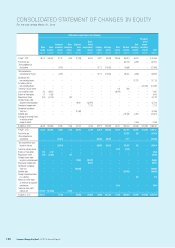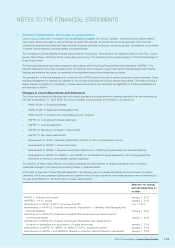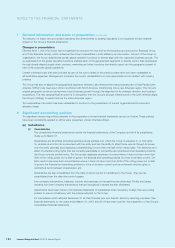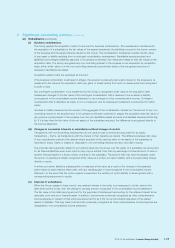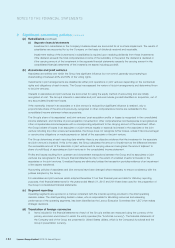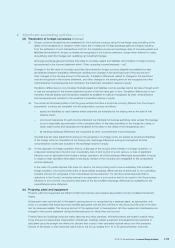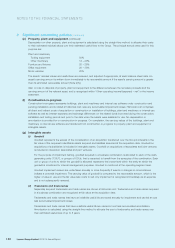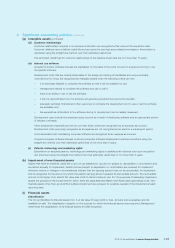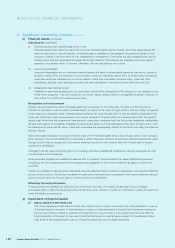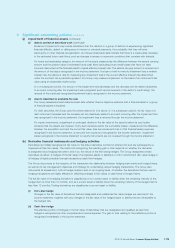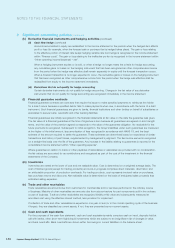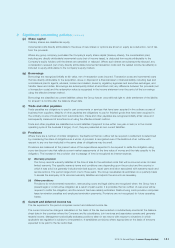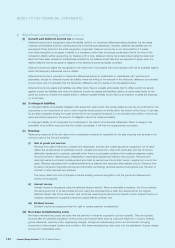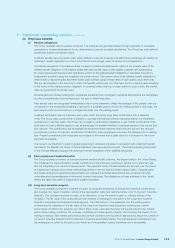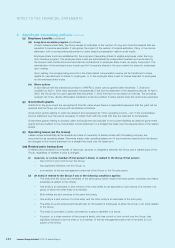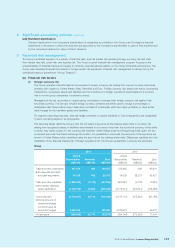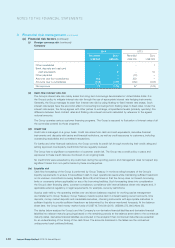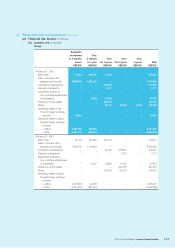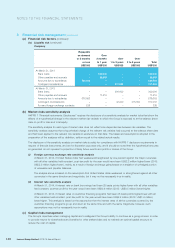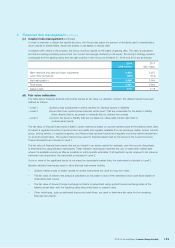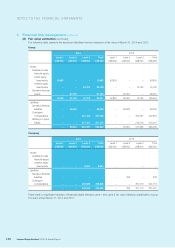Lenovo 2014 Annual Report Download - page 142
Download and view the complete annual report
Please find page 142 of the 2014 Lenovo annual report below. You can navigate through the pages in the report by either clicking on the pages listed below, or by using the keyword search tool below to find specific information within the annual report.
140 Lenovo Group Limited 2013/14 Annual Report
NOTES TO THE FINANCIAL STATEMENTS
2 Significant accounting policies (continued)
(k) Derivative financial instruments and hedging activities (continued)
(ii) Cash flow hedge (continued)
Amounts accumulated in equity are reclassified to the income statement in the periods when the hedged item affects
profit or loss (for example, when the forecast sale or purchase that is hedged takes place). The gain or loss relating
to the effective portion of interest rate swaps hedging variable rate borrowings is recognized in the income statement
within “Finance costs”. The gain or loss relating to the ineffective portion is recognized in the income statement within
“Other operating income/(expense) – net”.
When a hedging instrument expires or is sold, or when a hedge no longer meets the criteria for hedge accounting,
any cumulative gains or losses on the hedging instrument that has been recognized as other comprehensive income
from the period when the hedge was effective shall remain separately in equity until the forecast transaction occurs.
When a forecast transaction is no longer expected to occur, the cumulative gains or losses on the hedging instrument
that has been recognized as other comprehensive income from the period when the hedge was effective shall be
reclassified from equity to the income statement immediately.
(iii) Derivatives that do not qualify for hedge accounting
Certain derivative instruments do not qualify for hedge accounting. Changes in the fair value of any derivative
instruments that do not qualify for hedge accounting are recognized immediately in the income statement.
(l) Financial guarantee contracts
Financial guarantee contracts are contracts that require the issuer to make specified payments to reimburse the holder
for a loss it incurs because a specified debtor fails to make payments when due, in accordance with the terms of a debt
instrument. Such financial guarantees are given to banks, financial institutions and other bodies on behalf of subsidiaries or
associates to secure loans, overdrafts and other banking facilities.
Financial guarantees are initially recognized in the financial statements at fair value on the date the guarantee was given.
The fair value of a financial guarantee at the time of signature is zero because all guarantees are agreed on arm’s length
terms, and the value of the premium agreed corresponds to the value of the guarantee obligation. No receivable for the
future premiums is recognized. Subsequent to initial recognition, the Group’s liabilities under such guarantees are measured
at the higher of the initial amount, less amortization of fees recognized in accordance with HKAS 18, and the best
estimate of the amount required to settle the guarantee. These estimates are determined based on experience of similar
transactions and history of past losses, supplemented by management’s judgment. The fee income earned is recognized
on a straight-line basis over the life of the guarantee. Any increase in the liability relating to guarantees is reported in the
consolidated income statement within “Other operating expense”.
Where guarantees in relation to loans or other payables of subsidiaries or associates are provided with no consideration,
the fair values are accounted for as contributions and recognized as part of the cost of the investment in the financial
statements of the Company.
(m) Inventories
Inventories are stated at the lower of cost and net realizable value. Cost is determined on a weighted average basis. The
cost of finished goods (except for trading products) and work-in-progress comprises direct materials, direct labor and
an attributable proportion of production overheads. For trading products, cost represents invoiced value on purchases,
less purchase returns and discounts. Net realizable value is determined on the basis of anticipated sales proceeds less
estimated selling expenses.
(n) Trade and other receivables
Trade receivables are amounts due from customers for merchandise sold or services performed in the ordinary course
of business. Majority of other receivables are amounts due from subcontractors for part components sold in the ordinary
course of business. Trade and other receivables are recognized initially at fair value and subsequently measured at
amortized cost using the effective interest method, less provision for impairment.
If collection of trade and other receivables is expected in one year or less (or in the normal operating cycle of the business
if longer), they are classified as current assets. If not, they are presented as non-current assets.
(o) Cash and cash equivalents
For the purposes of the cash flow statement, cash and cash equivalents mainly comprise cash on hand, deposits held at
call with banks, other short-term highly liquid investments which are subject to an insignificant risk of changes in value,
and bank overdrafts. Bank overdrafts are shown within borrowings in current liabilities on the balance sheet.


